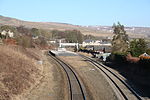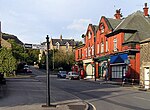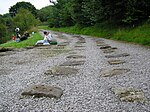Eccles Pike
Chapel-en-le-FrithMountains and hills of DerbyshireMountains and hills of the Peak DistrictMountains and hills of the United Kingdom with toposcopes

Eccles Pike is an isolated hill three miles west of Chapel en le Frith in the Derbyshire Peak District, England. It consists of gritstone, pink in colour at the summit. While not as prominent as the surrounding hills of Cracken Edge and Combs Moss, it is popular with walkers. At 370 metres (1,210 ft) above sea level, it offers good views of Manchester to the west and the Kinder Scout plateau to the east. Combs Reservoir lies just south of the hill. The name 'pike' means pointed hill; it's not known how it acquired the name Eccles, or whether this name relates to the town on the other side of Manchester famous for its currant cakes.
Excerpt from the Wikipedia article Eccles Pike (License: CC BY-SA 3.0, Authors, Images).Eccles Pike
Eccles Road, High Peak Chapel-en-le-Frith
Geographical coordinates (GPS) Address External links Nearby Places Show on map
Geographical coordinates (GPS)
| Latitude | Longitude |
|---|---|
| N 53.328 ° | E -1.949 ° |
Address
Eccles Pike
Eccles Road
SK23 9RS High Peak, Chapel-en-le-Frith
England, United Kingdom
Open on Google Maps











